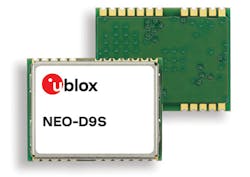L-Band Receiver Enables Centimeter-Level GNSS Positioning
In its NEO-D9S GNSS (Global Navigation Satellite System) correction-data receiver module, u-blox offers an affordable approach to centimeter-level accuracy in GNSS receivers. The NEO-D9S module receives GNSS correction data from correction service providers broadcast on the L-band (1525-1559 MHz). A host processor can then decrypt this correction data and deliver it to a high-precision GNSS receiver, combining corrections directly with readings from the satellite constellations to enable much more accurate position readings than those offered by GNSS signals alone.
Use of the NEO-D9S will also increase the availability of high-precision GNSS positioning data in areas with limited connectivity and reduce the amount of cellular data consumed by positioning receivers. Applications include automotive and OEM industrial-system integrators that offer position-correction services, and any other applications that rely on very accurate positioning at low cost.
The NEO-D9S module is a correction-only receiver based on u-blox’s 9th-generation (D9) platform. Thus, it will integrate easily with the company’s F9 RTK GNSS receivers, or it can become part of a modular product roadmap. The module also integrates a TCXO and SAW filter to ensure good RF sensitivity and resistance to interference from adjacent channels.
The module includes the algorithms necessary to decode satellite data broadcasts. Though configured to work initially with whichever correction service has been set as default, it can be configured for any L-band data broadcast. Configuration settings are stored in non-volatile memory.
About the Author
David Maliniak
Executive Editor, Microwaves & RF
I am Executive Editor of Microwaves & RF, an all-digital publication that broadly covers all aspects of wireless communications. More particularly, we're keeping a close eye on technologies in the consumer-oriented 5G, 6G, IoT, M2M, and V2X markets, in which much of the wireless market's growth will occur in this decade and beyond. I work with a great team of editors to provide engineers, developers, and technical managers with interesting and useful articles and videos on a regular basis. Check out our free newsletters to see the latest content.
You can send press releases for new products for possible coverage on the website. I am also interested in receiving contributed articles for publishing on our website. Use our contributor's packet, in which you'll find an article template and lots more useful information on how to properly prepare content for us, and send to me along with a signed release form.
About me:
In his long career in the B2B electronics-industry media, David Maliniak has held editorial roles as both generalist and specialist. As Components Editor and, later, as Editor in Chief of EE Product News, David gained breadth of experience in covering the industry at large. In serving as EDA/Test and Measurement Technology Editor at Electronic Design, he developed deep insight into those complex areas of technology. Most recently, David worked in technical marketing communications at Teledyne LeCroy, leaving to rejoin the EOEM B2B publishing world in January 2020. David earned a B.A. in journalism at New York University.


